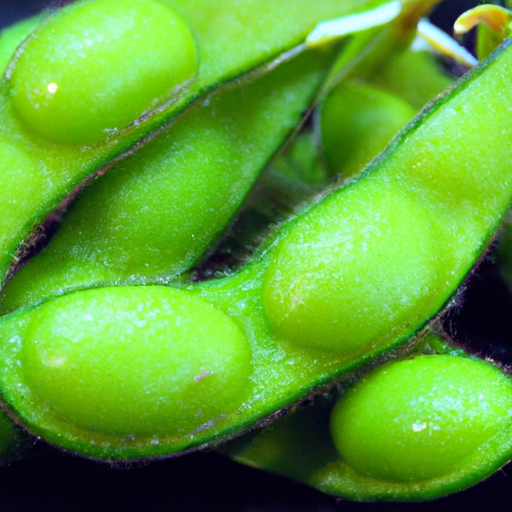Discover the Delightful Soy Beans in Pods: A Versatile Delicacy
Have you ever come across a vibrant green, slightly fuzzy vegetable in your local market and wondered what it could be? Look no further, for those are none other than soy beans in pods, also known as edamame. These little gems are not only visually appealing but also rich in flavor and nutrients. Whether you’re a seasoned food enthusiast or a budding cook, edamame deserves a place in your culinary repertoire.
The Taste of Edamame: Fresh, Nutty, and Mildly Sweet
When you bite into these emerald jewels, you’ll experience a delicate crunch followed by a burst of freshness. The flavor of edamame is nutty and subtly sweet, making it a delightful treat on its own or as a complement to various dishes. The texture is tender and creamy, inviting you to savor each bite.
Versatility in the Kitchen: From Appetizers to Main Courses
Edamame is astonishingly versatile, lending itself beautifully to an array of mouthwatering recipes. Here are some popular ways to incorporate these tender soy beans into your cooking:
1. Steamed Edamame: The simplest and most popular way to enjoy edamame is by steaming the pods until they are tender. Sprinkle some flaky sea salt over the top and present them as an appetizer or snack. The addictive nature of steamed edamame ensures they’ll vanish in no time!
2. Stir-fries and Noodle Dishes: Add a pop of color and a nutritious boost to stir-fries and noodle dishes by tossing in a handful of edamame. Their mild flavor blends effortlessly with other ingredients, creating a harmonious medley of flavors and textures.
3. Salads and Grain Bowls: Edamame brings an inviting vibrancy and protein-packed punch to salads and grain bowls. Toss them with fresh greens, vibrant vegetables, and your favorite dressing for a satisfying meal that’s both wholesome and bursting with flavor.
4. Soups and Stews: For an added dose of creaminess and texture, drop some edamame into soups and stews. Their subtle taste complements a wide range of broths and stocks, taking your dishes to new heights.
Nutritional Powerhouse: A Well-rounded Healthy Option
Not only is edamame delicious, but it also boasts an impressive nutritional profile. Packed with vitamins, minerals, and fiber, these bright green beans are a valuable addition to a balanced diet. Here are a few highlights of edamame’s nutritional value:
- Protein: Edamame provides a significant amount of plant-based protein, making it an excellent choice for vegans, vegetarians, and anyone looking to reduce their meat consumption.
- Fiber: High in fiber, edamame aids digestion and supports a healthy gut, promoting overall well-being.
- Vitamins and Minerals: Edamame is a good source of essential vitamins and minerals, including folate, vitamin K, iron, and magnesium, which play vital roles in maintaining optimal health.
A Brief History: From Asia to Global Fame
Although edamame is now enjoyed worldwide, this delightful legume has its roots in East Asia. With a history spanning thousands of years, edamame has long been a staple in Japanese and Chinese cuisines. In recent decades, its popularity has spread across the globe, captivating the taste buds of foodies and health-conscious individuals alike.
Interesting Facts About Edamame
Here are a few fascinating facts to pique your curiosity about edamame:
- Unlike mature soybeans, which are used for making tofu and soy milk, edamame is harvested before the beans have fully hardened.
- Edamame is incredibly sustainable! It enriches the soil with nitrogen, reducing the need for artificial fertilizers.
- In Japan, edamame is often served as a bar snack, accompanying a refreshing glass of beer or sake.
Whether you’re indulging in a steaming bowl of stir-fried noodles or enjoying a simple, salted handful of edamame, these vibrant green pods will undoubtedly bring joy and flavor to your culinary adventures. Embrace the versatility and nutritional benefits of edamame, and let your taste buds be the judge of this delightful legume!
So why wait? Head to your local market, grab a bag of edamame, and get ready to embark on a flavorful journey. Happy cooking!
Interesting Facts about Soybeans in Pods
Origin: Soybeans (Glycine max) are native to East Asia and have been cultivated in this region for thousands of years. They are believed to have originated in China around the 11th century BCE.
Common Uses: Soybeans in pods, known as edamame in Japanese, are a popular snack and ingredient in various cuisines. They are commonly boiled or steamed and served with a sprinkle of salt. Edamame is also used in salads, stir-fries, soups, and even pureed into dips.
Nutritional Benefits: Soybeans are highly nutritious and are rich in protein, dietary fiber, and essential minerals such as calcium, iron, and magnesium. They also provide a good source of vitamins including vitamin K, folate, and vitamin C. Furthermore, edamame contains all essential amino acids, making it a complete protein source.
Unique Properties: Soybeans in pods are unique because they are harvested before the beans fully mature and dry out. They are plump, green, and tender when harvested, making them ideal for consumption in their natural state. The pods are not edible and are typically discarded after removing the beans.
Historical Significance: Soybeans have played a significant role in Asian cuisines for centuries, especially in China, Japan, and Korea. Besides being a staple in the diet, they have been used to produce a wide range of soy-based products like soy sauce, tofu, miso, and soy milk. The cultivation and consumption of soybeans have spread to other parts of the world, making it one of the most widely grown and utilized crops globally.
Culinary Use: In addition to their nutritional value, soybeans in pods offer a delightful taste and texture. The beans inside the pods have a mild, slightly sweet flavor and a creamy yet firm texture. This makes them a versatile ingredient that can complement a variety of dishes, providing both taste and nutritional benefits.




Use the share button below if you liked it.
It makes me smile, when I see it.